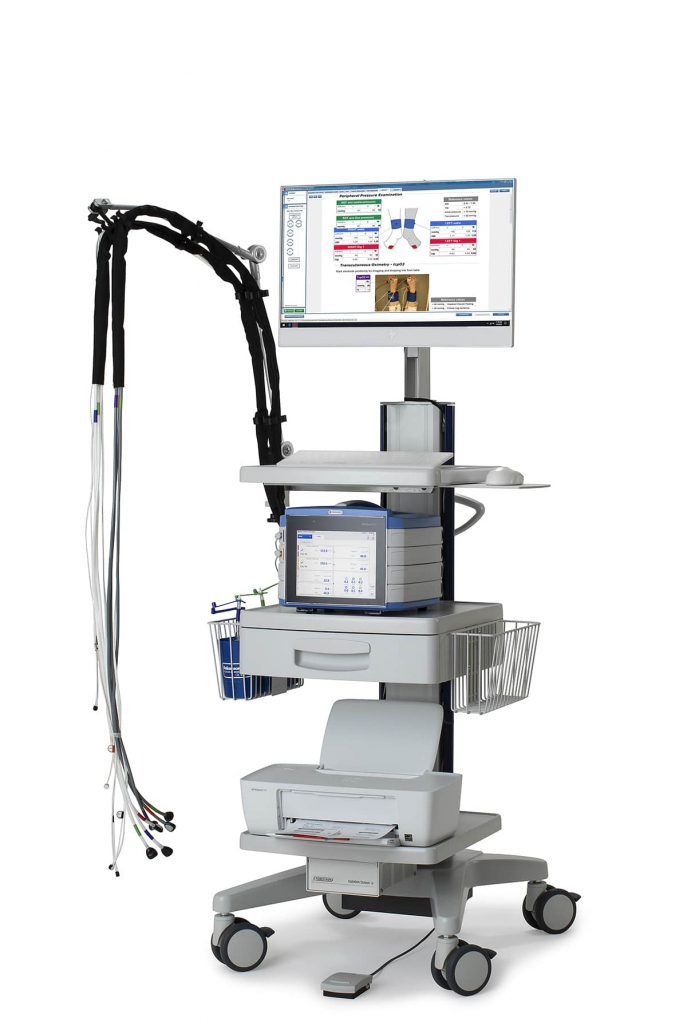What is
Chronic Limb Threatening Ischemia
(CLTI) (CLI)?
![]()
CLTI (Chronic Limb Threatening Ischemia) also known as CLI (Critical Limb Ischemia) is a more severe form of PAD 1PERIMED – Peripheral Artery Disease – Signs & Symptoms_04. (2020, March 31). Retrieved November 19, 2020, from https://dreambroker.com/channel/omhd1uia/rmgxxaiq with significant mortality, morbidity and higher use of health care resources.1 The distal blood flow and microcirculatory function are severely compromised resulting in rest pain, ischemic ulcers and gangrene. CLTI is a clinical diagnosis but should be supported by objective vascular testing. Due to the high risk of calcified vessels with falsely normal or high ABI, even in non-diabetics, toe pressures, PVR and tcpO2 must be used in all patients.
- 30% of all patients with confirmed CLTI have normal or high ABI.
- All patients with suspected CLTI should have toe pressure or tcpO2 to assess perfusion according to WIfI classification. 2
- The best modality to grade the level of ischemia and prioritize vascular procedures is tcpO2.
- Due to the complex nature of CLTI, all patients that undergo vascular intervention should be reassessed with toe pressure or tcpO2 to guarantee restored perfusion.
All-in-one simultaneous assessment
The PeriFlux 6000 Combined System offers the unique capability to simultaneously assess both Toe Pressure and PVR as well as measure Transcutaneous Oxygen in the tissue with one system saving limbs, lives, cost and reducing human suffering.
User-friendly software is guiding the user throughout the examination with a standardized measurement procedure for reliable and reproducible results.
A comprehensive report is instantly generated with all clinical information clearly stated with curves adding clarity. The report, as well as the workflow, can be customized to suit processes in clinical situations worldwide.
Perfusion imaging for PAD and diabetic foot ulcers
Perimed was the first company to commercialize laser-based microcirculation imaging and has over the past 40 years been the world leader in perfecting those techniques.
The PeriCam PSI provides a fast and accurate way to assess microcirculation in tissue by using laser speckle contrast analysis (LASCA or LSCI). It fits into the growing demand for non-invasive imaging techniques in diagnostics. All major guidelines [ref 1,2,3] on diagnosis and management of PAD and diabetic foot ulcers recognize the need for microcirculation assessment. The International Working Group on the Diabetic Foot (IWGDF) also highlights the need to investigate the role of novel methods of perfusion assessment [ref 3].
Recent expert reviews mentioned LSCI as a possible diagnostic technique to determine tissue perfusion in patients with PAD [ref 4] and/or diabetic foot ulcers [ref 5] and PeriCam PSI has shown to be a promising tool in these assessments [ref 6,7]. It can offer several advantages compared to other diagnostic techniques:
- Non-invasive
- No contact with patient needed
- No need for injectable contrast agents
- No ionizing radiation
- Ease of use
- Intuitive and powerful software for measurement setup, recording and analysis
- Small format system offers great flexibility in busy and crowded environments
- Easy to position due to flexible arm and ball head mount.
- Fast
- Real time imaging: up to ~100 images per second
The Pericam PSI Imaging system is clinically approved for measurement of microcirculation in the USA, Europe, China and many other markets.
References:
- Conte MS, Bradbury AW, Kolh P, et. al, Global Vascular Guidelines on the Management of Chronic Limb-Threatening Ischemia. Eur J Vasc Endovasc Surg. 2019 Jul;58(1S):S1-S109.e33. doi: 10.1016/j.ejvs.2019.05.006.
- Mills JL, Conte MS, Armstrong DG, et al. The Society for Vascular Surgery Lower Extremity Threatened Limb Classification System: Risk stratification based on Wound, Ischemia, and foot Infection (WIfI). J Vasc Surg. 2014;59(1):220034.e1-2. DOI: 10.1016/j.jvs.2013.08.003
- Hinchliffe et al. Guideline on diagnosis, prognosis and management of peripheral artery disease among people with diabetes (IWGDF 2019 update). Diab Metab Res Rev. 2020. e3276 DOI: 10.1002/dmrr.3276
- Kirsten F. Ma, Simone F. Kleiss, Richte C.L. Schuurmann, Reinoud P.H. Bokkers, Çagdas Ünlü & Jean-Paul P.M. De Vries (2019) A systematic review of diagnostic techniques to determine tissue perfusion in patients with peripheral arterial disease, Expert Review of Medical Devices, 16:8, 697-710, DOI: 10.1080/17434440.2019.1644166
- Onno A. Mennes, Jaap J. van Netten, Riemer H.J.A. Slart and Wiendelt Steenbergen, “Novel Optical Techniques for Imaging Microcirculation in the Diabetic Foot”, Current Pharmaceutical Design (2018) 24: 1304. DOI: 10.2174/1381612824666180302141902
- Anne Humeau-Heurtier, Pierre Abraham, Samir Henni, Bi-dimensional variational mode decomposition of laser speckle contrast imaging data: A clinical approach to critical limb ischemia?, Computers in Biology and Medicine 86, 2017, 107-112 DOI: 10.1016/j.compbiomed.2017.05.012
- A. Mennes, J.J. van Netten, J.G. van Baal, W. Steenbergen, Assessment of microcirculation in the diabetic foot with laser speckle contrast imaging, Physiological Measurement 40 065002 DOI: 10.1088/1361-6579/ab2058
- PERIMED – Peripheral Artery Disease – Signs & Symptoms_04. (2020, March 31). Retrieved November 19, 2020, from https://dreambroker.com/channel/omhd1uia/rmgxxaiq
Disclaimer: It is possible that the products on the Perimed website may not be cleared for sale in all markets.




